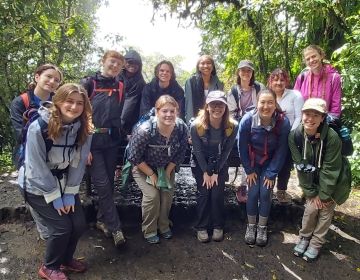Sustainability and the Environment: "Emma's Internship Report"
During the past four weeks I have been researching and building vertical gardens for the CIEE Sustainability Program. A vertical garden is any type of garden that utilizes vertical space. It can be as simple as a trellis for your tomatoes or as complex as hydroponic green wall scaling an office building. The more I learn about vertical gardens the more I see the potential benefits they have for Monteverde and locations around the world. One benefit of vertical gardens for a community such as Monteverde is as a tool for people to gain food security. As citizens in Monteverde live on smaller areas of land vertical gardens could allow them to grow large amounts of food in very small spaces. In my internship I have built four vertical gardens and I hope that they will be used as an educational tool for the surrounding communities of Monteverde and Santa Elena. Vertical gardens are also an effective way to up cycle and reuse material that would otherwise be thrown away. My gardens use plastic bottles, repurposed wood, and bamboo that grows as an invasive species in the area. All my designs were very inexpensive to build and are sustainable. The great benefit of vertical gardens is anyone could build one, almost anywhere, using a wide range of materials!
Going into my internship I knew next to nothing about vertical gardens and had no background in construction or carpentry. With the help of my adviser Orlando Calvo I have gained valuable skills in how to design, identify available materials, and build a product. I learned basic construction skills that I plan to use in future projects. With my research and new information, I now see many valuable uses for vertical gardens. They can be much more than just an aesthetic piece in someone's yard. Vertical gardens have the potential to produce very large yield in a small space, they can act was a wind and privacy buffer, they can improve air quality, they are economical and ecological, and they have many other benefits.
For this internship I created four vertical gardens, they range in construction difficulty and design. My first garden is built using bamboo, plastic bottles and wire. I cut large plastic soda bottles into planters and attached them by building a bamboo frame. This model is growing tomato plants and has been wired to the back fence of the study center. My second garden is a stair step vertical garden with an attached trellis. It is made using repurposed wood for the base with bamboo and wire for the trellis. This garden allows for the growth of a variety of plants because of the different soil depths of the beds and attached trellis for vines to follow. For my third garden, I hollowed out bamboo into gutters to hold native epiphytes. My last garden was the most difficult to design and build, and my personal favorite. It is a flow through water system designed to keep the soil for all the plants wet while conserving water. The top is bamboo flowerbeds that were built at an angles and connected with piping. The water collects at the bottom in a flowerbed made of repurposed wood. Below are some photos of my vertical gardens and building processes.
Related Posts
Happy Earth Day: Today and Every Day
Happy Earth Day! Every April 22, this global event comes around to remind us how precious our planet is, what sustainable efforts we can make to protect Earth, and that... keep reading
Top 10 Study Abroad Volunteer Opportunities with CIEE
Have you ever wondered if you could volunteer abroad? Perhaps you're looking into study abroad programs that provide international volunteer opportunities. If you’re itching to study abroad and truly make... keep reading
Recycling Internship with ADI San Luis
Written by Maya Peske (Cornell College), Internship in Sustainability and the Environment The road from San Luis up to Monteverde is well known by all of the people in the... keep reading



